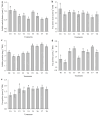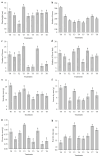The Combination of Salicylic Acid, Nicotinamide, and Proline Mitigates the Damage Caused by Salt Stress in Nasturtium (Tropaeolum majus)
- PMID: 40284044
- PMCID: PMC12030097
- DOI: 10.3390/plants14081156
The Combination of Salicylic Acid, Nicotinamide, and Proline Mitigates the Damage Caused by Salt Stress in Nasturtium (Tropaeolum majus)
Abstract
Salinity represents a significant challenge for agriculture, especially in semi-arid regions, affecting the growth and productivity of plants such as nasturtium (Tropaeolum majus), which is valued for its ornamental, medicinal, and food uses. Salt stress disrupts biochemical, physiological, and anatomical processes, limiting plant development. This study investigated the application of attenuators, including salicylic acid, nicotinamide, and proline, to mitigate the effects of salt stress on nasturtium cultivated in a hydroponic system. The treatments involved different combinations of these compounds under saline conditions (40 mM NaCl). The attenuators reduced the negative impacts of salt stress, promoting improvements in gas exchange, such as increased net photosynthesis, water-use efficiency, and stomatal conductance. Additionally, the treatments enhanced vegetative and reproductive growth, increasing the dry biomass of leaves, stems, and flowers, as well as the number of flowers and flower buds. The combination of salicylic acid, nicotinamide, and proline stood out by providing greater efficiency in carbon assimilation, stability of photosynthetic pigments, and higher tolerance to salt stress. These findings reinforce the potential of using attenuators to optimize the cultivation of nasturtium in saline environments, promoting higher productivity and plant quality.
Keywords: abiotic stress; amino acids; edible flowers; gas exchange; inorganic and organic solutes; plant hormones; vitamin B3.
Conflict of interest statement
The authors declare no conflicts of interest.
Figures






References
-
- Silva T.I., Dias M.G., de Araújo N.O., Santos M.N.S., Ribeiro W.S., dos Santos Filho F.B., Grossi J.A.S. Spermine Reduces the Harmful Effects of Drought Stress in Tropaeolum majus. Sci. Hortic. 2022;304:111339.
-
- Silva T.I.D., Dias M.G., Barbosa L.B., de Araújo N.O., Ferreira F.D., Grossi J.A.S., Costa F.B.D., Marco C.A., Ribeiro D.M. Spermine Decreases Ethylene and Increases Sugars and Phenolic Compounds in Nasturtium Flowers Grown Under Drought and Salt Stress. Bragantia. 2023;82:e20230041.
-
- Cobus D., Nunes G., Maior L.O., Lacerda L.G., Ito V.C. Unconventional Food Plants (UFPs): An Approach to the Nutritional and Functional Properties of Nasturtium (Tropaeolum majus L.) Food Sci. Today. 2023;1:1–10. doi: 10.58951/fstoday.v1i1.4. - DOI
-
- Lourenço E.L.B., Muller J.C., Boareto A.C., Gomes C., Lourenço A.C., Minatovicz B., Crestani S., Gasparotto Junior A., Martino-Andrade A., Dalsenter P.R. Screening for In Vivo (Anti) Estrogenic and (Anti) Androgenic Activities of Tropaeolum majus L. and Its Effect on Uterine Contractility. J. Ethnopharmacol. 2012;141:418–423. - PubMed
LinkOut - more resources
Full Text Sources

